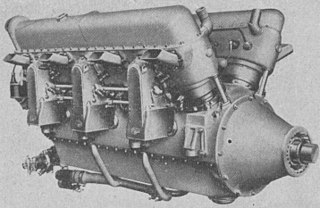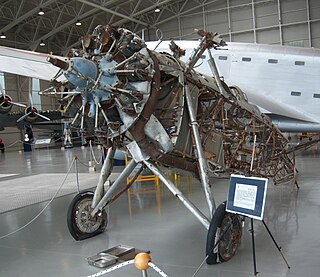| A.24 | |
|---|---|
 | |
| A.24R | |
| Type | Water-cooled V-12 |
| Manufacturer | Fiat Aviazione |
| First run | c.1926 |
| Number built | at least 100 |
The Fiat A.24 was an Italian water-cooled aircraft engine from the 1920s.
| A.24 | |
|---|---|
 | |
| A.24R | |
| Type | Water-cooled V-12 |
| Manufacturer | Fiat Aviazione |
| First run | c.1926 |
| Number built | at least 100 |
The Fiat A.24 was an Italian water-cooled aircraft engine from the 1920s.
During the second half of the 1920s Fiat introduced several water-cooled aircraft engines, including the A.20, A.22, A24, A.25 and A.30. [1] They were all upright V-12s with 60° between the cylinder banks; capacities ranged between 18.7 L and 54.5 L (1,141-3,326 cu in) and power outputs between 320 kW and 745 kW (430-1,000 hp). [1] [2] Producing 520 kW (700 hp) from 32.3 L (1,971 cu in), the A.24 was near the center of this range.
When Fiat was advised by the Italian government to simplify their water-cooled product line, they decided to focus on the A.20, A.22 and A.30 models such that the A.24 was not manufactured in large numbers. [1] [2]
From Thompson. [3]
Data fromJane's All the World's Aircraft 1938. [2]
Related lists

The Piaggio P.XI was an Italian 14-cylinder radial aircraft engine. The P.XI was a licensed derivative of the French Gnome-Rhône Mistral Major 14K produced in Italy. Isotta Fraschini also produced a version of the 14K called the K.14.

The Fiat A.80 was an 18-cylinder, twin-row, air-cooled, radial aircraft engine produced during World War II. Rated at 1,000 hp (745 kW), it was a more powerful development of the 14-cylinder Fiat A.74.

The Alfa Romeo 115 was an Italian six-cylinder air-cooled inverted inline engine for aircraft use, mainly for training and light planes, based on the de Havilland Gipsy Six engine. Production totalled approximately 1,600 units. Derivatives of the 115 include the -1, bis, ter and Alfa Romeo 116.

The Walter Venus was a seven-cylinder, air-cooled, radial engine for aircraft use, built in Czechoslovakia in the late 1920s.

Alfa Romeo built/designed a range of aircraft engines based on the Bristol Jupiter and Bristol Pegasus designs, designated Alfa 125, Alfa 126, Alfa 127, Alfa 128, Alfa 129 and Alfa 131. All these essentially similar engines were mainly fitted to Italian bombers in World War II, Alfa Romeo building around 11,000 units between 1934 and 1944

The Alfa Romeo 135 Tornado was an Italian 18-cylinder radial engine designed by Giustino Cattaneo in 1934–1935.

The Praga B2 was a low powered aero engine suitable for very light aircraft. It dates from the mid-1930s.
The Fiat AS.5 was an Italian 12-cylinder, liquid-cooled V engine designed and built in the late-1920s by Fiat especially for the 1929 Schneider Trophy air race.
One of Avia's own designs, the 1930s Avia Rk.12 was a seven-cylinder radial engine with a rated output of 150 kW (200 hp), built in Czechoslovakia.

The Lorraine 12H Pétrel was a French V-12 supercharged, geared piston aeroengine initially rated at 370 kW (500 hp), but later developed to give 640 kW (860 hp). It powered a variety of mostly French aircraft in the mid-1930s, several on an experimental basis.

The Asso XI was a family of water-cooled, supercharged V12 piston aeroengines produced in the 1930s by Italian manufacturer Isotta Fraschini, and fitted on a number of aircraft types built by CANT, Caproni and others.
The CNA C-7 was a small nine-cylinder supercharged, geared, single row radial engine designed in Italy in the early 1930s. Three light aircraft class world altitude records were set by the CNA C-7 powered Fiat AS.1 and CNA Eta.

The Walter Sagitta was a Czechoslovakian, air-cooled, inverted V-12 engine that first ran in 1937. This was one of several smaller, low-mass medium power pre-war V-12 engines produced. With a displacement of 18.4 liters, it produced up to 373 kW at 2,500 rpm.

The Fiat A.30 R.A. was an Italian water-cooled aircraft engine from the 1920s, built in large numbers and serving with several air forces up to the beginning of World War II. It produced 447 kW (600 hp).

The Fiat A.22 was an Italian water-cooled aircraft engine from the 1920s. It produced 425 kW (570 hp) and powered several absolute world distance records as well as commercial passenger flights.

The Fiat A.25 was an Italian water-cooled aircraft engine from the 1920s. It produced 708 kW (950 hp) and was used by the Regia Aeronautica for fifteen years to power their Fiat BR.2 and BR.3 bombers.

The Fiat AN.1 was an experimental Italian water-cooled diesel straight six cylinder aircraft engine from the late 1920s.
The Caffort 12Aa was a 12-cylinder, horizontally-opposed, piston aircraft engine designed and built in France during the latter half of the 1920s.

The Isotta Fraschini Asso 750 was an Italian W 18 water-cooled aircraft engine of the 1930s. Produced by Isotta Fraschini the engine displaced just under 48 l (2,900 cu in) and produced up to 940 hp (700 kW). Together with the Asso 200 and the Asso 500 the Asso 750 was part of a family of modular engines, that used common and interchangeable components to lower production costs.

The Piaggio P.IX, or Piaggio Stella P.IX, was an Italian nine-cylinder radial aircraft engine produced by Rinaldo Piaggio S.p.A. Based on the Gnome-Rhône 9K, the engine was rated at 600 hp (447 kW). Production was used to power a number of other aircraft developed in Italy. The main users were the Savoia-Marchetti SM.81 transport and the IMAM Ro.37bis, the main reconnaissance aircraft in the Regia Aeronautica during the Second Italo-Ethiopian War, Spanish Civil War and Second World War, but the engine was also used by other designs, including the prototype Savoia-Marchetti SM.79.